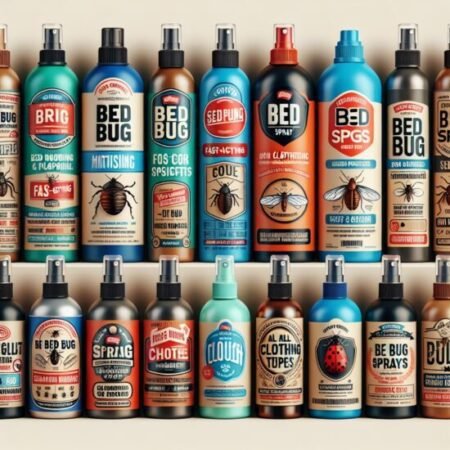
Introduction to Bed Bug Sprays for Clothes
Bed bug infestations are on the rise, making it crucial to protect our belongings, especially our clothes, from these stubborn pests. In this article, we’ll explore effective bed bug sprays that are specifically designed for treating clothes.
Whether you’re dealing with a small infestation or looking for preventive measures while traveling, these sprays can be a valuable solution to:
- Safeguard your wardrobe
- Prevent the spread of bed bugs
We’ll not only discuss a variety of bed bug sprays for clothes but also explore natural remedies and additional tips for comprehensive clothing protection against bed bugs.
As we go through the different options, you’ll discover various ways to deal with bed bugs on clothes and find practical solutions that suit your needs.
1. Natural Solutions for Bed Bugs on Clothes

Certain natural ingredients can effectively repel or eliminate bed bugs from clothes without the use of harsh chemicals. These remedies provide a more environmentally friendly and potentially safer option for treating bed bug infestations on clothing items.
Lavender Essential Oil
Lavender essential oil is known for its strong scent properties that make it effective against bed bugs. Here’s how you can use it:
- Apply a few drops of therapeutic grade lavender essential oil to cotton balls.
- Place the cotton balls in your closets, drawers, or storage bins to deter bed bugs.
- You can also mix lavender essential oil with water in a spray bottle and directly apply it to clothing and infested areas.
It’s important to keep in mind that while lavender is generally safe, some individuals may have allergic reactions, so it’s advisable to perform a patch test before widespread use.
Garlic
While garlic is often touted as a natural insect repellent, its effectiveness in deterring bed bugs from clothes has not been extensively studied. Some people believe that the strong odor of garlic may repel bed bugs, but its limitations and potential impact on fabric should be considered when exploring this option.
Rosemary
Rosemary is another herbal remedy that is believed to deter bed bugs from garments. Here’s how you can use it:
- Create a homemade sachet using dried rosemary.
- Place the sachet with your clothes to help prevent infestations.
- Regularly replace or refresh the rosemary sachets to maintain their effectiveness.
These natural solutions offer alternative methods for protecting your clothes from bed bugs and can be used in conjunction with other preventive measures for comprehensive clothing protection.

2. Using Permethrin Sprays to Get Rid of Bed Bugs on Clothes
- Permethrin is a commonly used insecticide for treating bed bugs on fabrics.
- It works well against a wide range of pests and continues to be effective even after application.
Research Backing its Effectiveness
- Scientific studies have shown that permethrin-based sprays are highly effective in killing and repelling bed bugs on clothes.
- When applied to fabric, permethrin exhibits strong insecticidal properties, making it a reliable choice for treating clothing infested with bed bugs.
Safety Precautions
- It’s important to address any concerns about potential harm to humans from using permethrin products.
- Emphasize the need for proper usage and handling of permethrin-treated garments to minimize any risks involved.

3. Other Remedies and Repellents for Bed Bugs on Clothes
When dealing with bed bug infestations on clothing, sprays are not the only option. There are alternative approaches that can be just as effective in getting rid of bed bugs on clothes. Here are some other remedies and repellents to consider:
1. Steam Treatment
One effective method of eliminating bed bugs from clothes is subjecting them to high heat. Steam treatment can be highly effective in killing bed bugs and their eggs, as the heat penetrates the fabric and destroys these pests. To use this method, you can invest in a garment steamer or utilize a steam cleaner with an attachment for clothing. Make sure to thoroughly steam all areas of the infested clothing, paying close attention to seams, folds, and pockets. Steam treatment is a safe and chemical-free way to eliminate bed bugs from clothes.
2. Freezing
Another option for treating bed bugs on clothes is freezing them. Extreme cold temperatures can also kill bed bugs and their eggs. If you have items that can’t be washed or steamed, placing them in a sealed plastic bag and leaving them in the freezer for several days can help eliminate the pests. However, it’s important to note that this method may not be as effective as heat treatment.
3. Dry Cleaning
For delicate clothing items that cannot be washed or subjected to high heat, dry cleaning can be an effective solution. The chemicals used in the dry cleaning process can kill bed bugs and remove any infestation from your clothes.
4. Washing with Hot Water
The simplest way to get rid of bed bugs on clothes is by washing them with hot water. Bed bugs cannot survive in high temperatures, so using hot water for washing your infested clothes can help eliminate them.
It’s important to note that while each of these methods can be effective on its own, combining multiple strategies will provide a more holistic approach to tackling bed bugs on clothes. By using a combination of sprays, steam treatment, and other remedies, you can increase your chances of successfully eliminating these pesky insects from your garments.
Remember, prevention is key when it comes to protecting your clothes from bed bugs. Regular inspection and cleaning routines, along with proper storage techniques, can help minimize the risk of infestation. Additionally, taking precautions while traveling can prevent you from bringing bed bugs home through your luggage and clothing items.
4. Protecting Clothes from Bed Bugs: Additional Measures

When it comes to protecting your clothes from bed bugs, taking proactive measures is key to preventing infestations. Regular inspection and cleaning routines for your clothing can help identify and address any potential issues before they become major problems.
Vacuum-Sealed Bags
One effective method for safeguarding your garments is to use vacuum-sealed bags for storing off-season clothes. These airtight bags create an inhospitable environment for bed bugs, reducing the risk of infestation during storage periods. This is similar to how these bags also protect against clothes moths that can cause damage to your wardrobe.
Essential Oil Spray
In addition to vacuum-sealed bags, you can explore natural prevention methods such as creating a homemade essential oil spray with bed bug repellent properties. Lavender oil, known for its insect-repelling qualities, can be used as a key ingredient in this DIY spray to help protect your clothes from bed bugs.
Moth Balls
While moth balls have been traditionally used to deter moths, some individuals also consider them as a possible deterrent for bed bugs on clothes. However, it’s important to carefully consider any potential drawbacks or safety concerns associated with using moth balls before incorporating them into your clothing protection strategy.
5. Tips for Protecting Your Clothes from Bed Bugs While Traveling

Travelers need to be particularly cautious about bringing bed bugs home through their luggage and clothing items. To ensure your clothes remain bed bug-free while traveling, here are some tips to follow:
1. Hotel Room Checks
When you arrive at your hotel, it’s essential to inspect the room for any signs of bed bugs. Follow these step-by-step guidelines to conduct a thorough inspection:
- Start by examining the mattress seams, paying close attention to the corners and edges.
- Check the headboard, as well as any upholstered furniture in the room.
- Inspect curtains, picture frames, and electrical outlets, as bed bugs can hide in these areas.
- Look for dark stains or spots on the bedding, which could indicate the presence of bed bug excrement.
- Use a flashlight to illuminate dark corners and crevices where bed bugs might hide.
2. Dorm Precautions
College students living in dorms should take extra precautions to minimize the risk of bed bug infestations in their clothing within shared living spaces. Here are some practical measures to consider:
- Keep your clothes stored in sealed plastic bags or airtight containers to prevent bed bugs from accessing them.
- Avoid leaving clothes on the floor or in piles where bed bugs can easily crawl onto them.
- Regularly inspect your dorm room for signs of bed bugs, such as blood spots on bedding or small black dots (their excrement).
- If you suspect a bed bug infestation, notify your resident advisor or housing authorities immediately.
Remember that prevention is key when it comes to protecting your clothes from bed bugs while traveling. By following these tips and remaining vigilant, you can significantly reduce the risk of bringing these unwanted pests home with you.
Recommended Products for Treating Bed Bugs on Clothes
When it comes to treating bed bugs on clothes, there are a few options you can consider. Severe infestations may require the assistance of professional exterminators or specialized laundry services with heat treatments. However, if you prefer a DIY approach, here are some recommended products and methods to effectively eliminate bed bugs from your clothes:
- Bed bug sprays: Utilizing bed bug sprays can be an effective way to treat infested clothing. You can choose from both natural and permethrin-based sprays depending on your preference. Natural sprays often contain ingredients like lavender essential oil, garlic, or rosemary, which have repellent properties against bed bugs. Permethrin-based sprays, on the other hand, are insecticides specifically designed to kill and repel bed bugs.
- Hot wash and dry cycles: Another non-chemical method you can use is washing and drying your infested clothes at high temperatures. Bed bugs cannot survive extreme heat, so subjecting your clothes to hot wash and dry cycles can effectively kill them and their eggs.
It’s important to note that while these methods can be effective in treating bed bugs on clothes, they may not completely eliminate an infestation if it has spread beyond your garments. In such cases, it’s advisable to seek professional help for a more comprehensive treatment.
Additionally, educating yourself about these pests is crucial in order to effectively deal with them. Websites like the ones provided by Rutgers University and the University of Kentucky offer valuable information on bed bug prevention and control.
Remember, prevention is always better than cure when it comes to bed bugs. Regularly inspecting your clothing for signs of infestation and practicing good hygiene can help minimize the risk of encountering these pests.
By combining bed bug sprays with non-chemical methods like hot washing and drying, you can take a proactive approach in protecting your clothes from these unwanted visitors.
Conclusion
It is crucial to address bed bugs on clothes as soon as possible to prevent the infestation from spreading to other areas of the home. Regularly inspecting clothes and taking immediate action can help minimize the damage caused by these pests.
The article has provided a range of effective bed bug sprays for clothes, including natural solutions like lavender essential oil and permethrin-based sprays. Each approach has its advantages and limitations, so it’s important to choose the one that best suits your needs.
While using bed bug sprays is an effective way to protect your clothes, it’s also essential to maintain good hygiene practices. Keeping your bedroom clean, vacuuming regularly, and minimizing potential hiding spots for bed bugs will go a long way in preventing infestations.
FAQs (Frequently Asked Questions)
What natural remedies can be used to repel or eliminate bed bugs from clothes?
Natural remedies such as lavender essential oil, garlic, and rosemary can be used to repel or eliminate bed bugs from clothes. These natural ingredients offer an alternative to harsh chemicals and can be effective when applied properly.
How can lavender essential oil be used to repel bed bugs from clothes?
Lavender essential oil is known for its strong scent properties that make it effective against bed bugs. It can be applied to clothes using methods such as diluting the oil in water and spraying it onto the fabric. However, it’s important to take precautions and avoid direct contact with skin or ingestion of the oil.
What is permethrin and how effective is it in treating bed bugs on clothes?
Permethrin is a common insecticide used in bed bug treatments for fabrics due to its residual effects and broad spectrum activity against pests. Scientific research supports its effectiveness in killing and repelling bed bugs on clothes, making it a popular choice for treating infestations.
What are some additional measures for protecting clothes from bed bugs?
In addition to using sprays and natural remedies, additional measures for protecting clothes from bed bugs include heat treatment, vacuum-sealed bags for storage, essential oil sprays, and even the use of moth balls. These proactive measures can help minimize the risk of infestations and protect clothing items.
Why do travelers need to be cautious about bringing bed bugs home through their luggage and clothing items?
Travelers need to be cautious about bringing bed bugs home through their luggage and clothing items because infestations can quickly spread to other areas of the home. This is why it’s important to inspect hotel rooms, dorms, and suitcase protection methods to minimize the risk of bringing bed bugs back home.
What are some recommended products for treating severe bed bug infestations on clothes?
Severe bed bug infestations on clothes may require professional intervention, such as the assistance of pest control companies or laundry services with specialized heat treatments. For a DIY approach, using a combination of bed bug sprays (both natural and permethrin-based) along with non-chemical methods like hot washing/drying infested clothes at high temperatures can also be effective.







2 thoughts on “10 Bed Bug Sprays for Clothes That Actually Work”